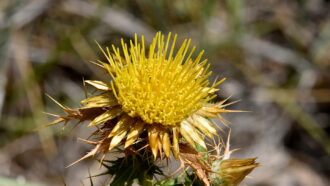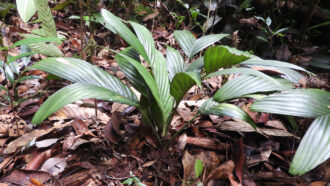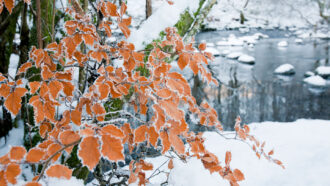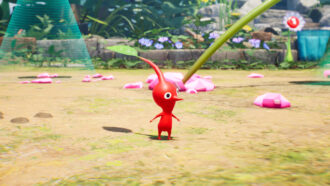These ferns may be first plants known to work together as ants do
The plants may live in a communal lifestyle never seen outside of the animal kingdom
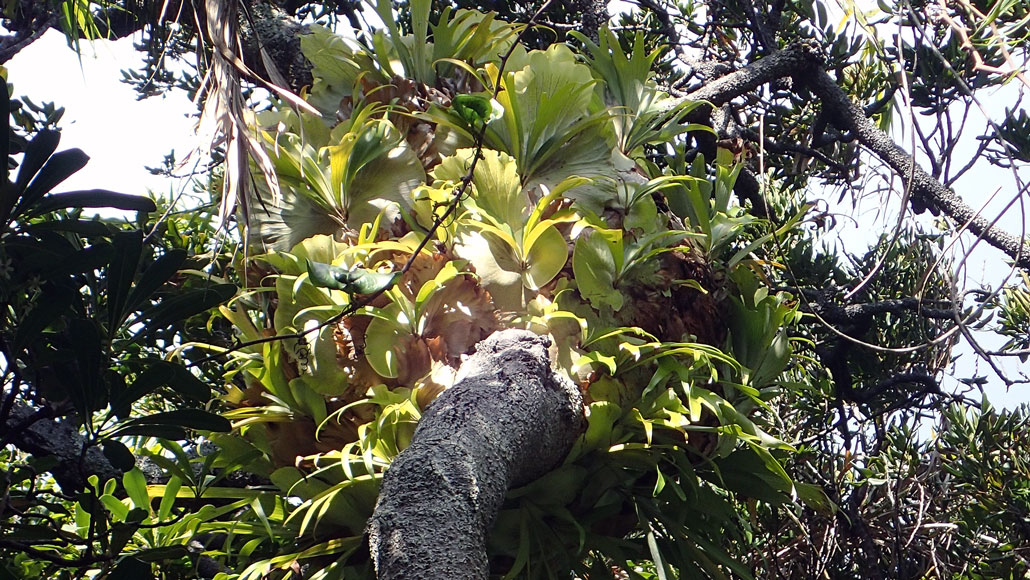
Many of this fern colony’s fan-shaped nest fronds (growing close to the tree trunk) are sterile. Thinner strap fronds (sticking up and out from between the nest fronds) are the more reproductively active members of the colony.
Ian Hutton
By Jake Buehler
A mass of strange ferns grips a trunk high among the treetops. They look like a giant tangle of floppy, green antlers. Below their fork-shaped fronds and closer into the core of this lush knot of greenery are brown, disc-shaped plants. These, too, are ferns. They are even the same species. Together these individuals form a society.
And this type of society has only ever been seen in animals, especially bees, termites and ants.
Staghorn ferns — and possibly other plants — appear to work together. Each takes on different tasks that together aid their society.
Kevin Burns is a biologist at Victoria University of Wellington. It’s in New Zealand. He first became familiar with the ferns while working on Lord Howe, an isolated island between Australia and New Zealand. He took notes on local island epiphytes (EP-ih-fytes). These are plants that grow on other plants. And one species caught his eye. This staghorn fern (Platycerium bifurcatum) is native to parts of mainland Australia and Indonesia, too.
“I realized,” Burns recalls, these ferns “never occur alone.” Some of the larger clusters were massive. They contained hundreds of individuals. And Burns soon realized “each one of those individuals was doing a different thing.”
He likens the fern colonies to an upside-down umbrella. Some with long, green, waxy “strap” fronds appeared to direct rain water to the center of the clump. There, spongey disc-shaped, brown “nest” fronds soaked up this moisture.
The whole community reminded Burns of a termite mound. Those mounds house a communal store of resources. Inside it, various members of the termite colony perform different tasks.
Scientists call such cooperative groups eusocial (Yu-SOH-shul). Overlapping generations live together in castes, with each performing different roles. Among eusocial animals, some might be dedicated workers. Others could be nurses or nannies.
Eusocial has been used to describe certain societies of insects and crustaceans, along with two species of mole rats. Burns wondered if ferns, too, might be eusocial.
His team’s data now indicate they are. These ferns appear to form a complex society made up of interdependent groups. Burns and his coworkers described their surprising discovery online May 14 in Ecology.
Truly eusocial? Let me count the ways
Ferns reproduce via spores. These form on the underside of leaf-like fronds. Some four in every 10 fronds of the studied communities of staghorn ferns could not reproduce. They mostly served as nests for others. Another fern has what’s known as “strap” fronds. It did develop fertile spores. This suggests a division of labor between fronds that do and don’t form nests.
Tests also showed that nest fronds sop up more water than strap fronds do. Earlier work by other scientists had found networks of roots running throughout the colony. Using them, nest fronds can share their water, slaking the thirst of neighboring strap fronds.
Burns and his coworkers also analyzed the genes in 10 staghorn colonies on Lord Howe Island. Eight hosted genetically identical individuals. Only two colonies contained individuals whose genetics differed. Such a high degree of genetic relatedness is seen in colonies of eusocial insects. In ants and bees, for instance, many sisters contribute to the survival of their home nest.
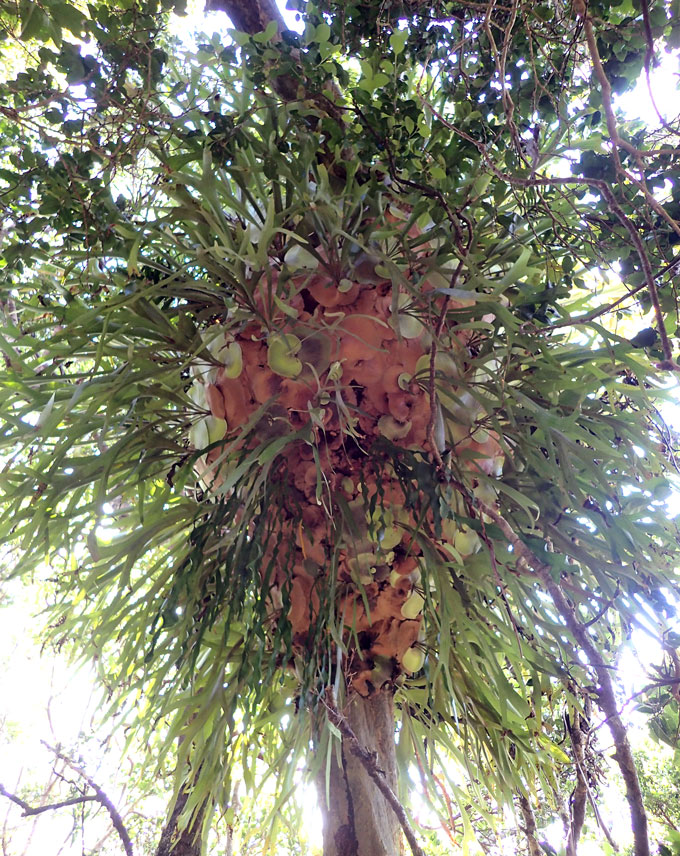
Burns thinks the staghorns’ newfound traits tick many of the boxes needed to support a claim that they, too, are eusocial.
Scientists had largely assumed that eusocial colonies coordinate the behaviors of their members to meet the community’s joint needs. Tasks would seem to be intentional, requiring thought. But seeing eusocial plants, Burns says, “seems to indicate to me that this type of transition in the evolution of complexity doesn’t require a brain.”
Looking at epiphytes as eusocial is “really cool,” says Michelle Spicer. She’s an ecologist. She works at the University of Puget Sound in Washington.
To Burns, the division of labor to build communal resources “appears to be a key feature that sets staghorn [ferns] apart from other colonial plants.” A stressful life in the treetops — far from the soil — may have helped the ferns’ evolve eusocial traits, Burns says. The society these plants create allows all members to share in scarce supplies of water and nutrients.
Spicer points out, however, that a sharing of water and nutrients also occurs among other epiphytes.
The new study makes a good case that staghorn ferns are eusocial, says Brian Whyte. “The epiphyte lifestyle certainly facilitates group living,” he adds. “And group living is where all social stories start.” Whyte is an evolutionary biologist. He works at the University of California, Berkeley.
Whyte is fascinated by how staghorns form colonies in the wild, where members perform different, individual tasks. However, he notes, when grown in soil as ornamental plants, these ferns don’t need a community. They now form individual strap fronds. Such variability is not typical of eusocial species, he says.
Burns and his colleagues are currently studying whether strap fronds can become nest fronds when they are moved to another part of a colony. Burns also wants to study a second staghorn-fern species that appears to grow in colonies. That one is in Madagascar.
Burns says he’s really excited to have found something in the wild that unexpectedly turns out to be “comparable to some of the coolest, most advanced societies in the living world.” And regardless of how eusocial these ferns are, they still have intriguing similarities and differences from caste-forming animals, he adds. “Learning more about [these ferns] will improve our theories on why these characteristics have evolved across the diversity of life.”

